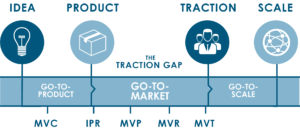The go-to-market phase — as outlined in the Traction GapTM Framework — begins with a startup’s first product release, and ends with market validation and a foundation to scale. Within this phase are four value inflection points: Initial Product Release (IPR), Minimum Viable Product (MVP), Minimum Viable Repeatability (MVR) and Minimum Viable Traction (MVT).

However, before you can enter the go-to-market phase, your startup must reach an earlier milestone: Minimum Viable Category (MVC). A category is just a different name for a problem: what problem does your solution solve?

Your challenge is to either define a new category or redefine one that currently exists. Attempting to compete in an existing category is a recipe for disaster; the current category leader (“the category king”) determines the rules of the category (product features/attributes) and the rules of engagement (business model). As a startup, you are ill-equipped to take on a category king. You must build a different kingdom (category) that you can rule.
If you expect to survive (and eventually thrive) as a company, you must perform market engineering work early on. One of the key market engineering tasks you must complete is to establish your Minimum Viable Category (MVC) by naming it, defining its attributes, and creating the value propositions associated with it.
The Importance of Categories
Why is category design so important? Simply put, we are natural comparers. Though we enjoy novelty, we have to be convinced to change our habits — whether personal or business-related — and we instinctively compare any new offering with what we already know. This is how we determine where innovative ideas and products fit into our existing reality.

Steve Jobs didn’t invent the cell phone or the tablet categories. When he introduced the Apple iPhone and iPad, he created two new and unique categories with novel attributes such as a touchscreen UI and the ability to host and run mobile applications using both cellular and wifi networks.
Similarly, a startup needs to quickly and effectively explain its product, where that product “fits in” and why anyone would need it. One way to know that you have successfully named and defined a new category is to create an “elevator pitch”. Can you briefly (and successfully) state the name of your company, what you do, why your product is different/unique, and why it is important?
People’s attention spans are short, and if you can’t grab them in a moment, you will probably never grab them at all.
You’d be amazed at how many CEOs/founders are unable to succinctly tell their story. Many can’t effectively communicate why they are different than the competition and why the world is better off with their product than without. It’s a recipe for failure.
B2B startups that fail to explain their category find themselves in delayed sales cycles, and find it challenging to escape the shadow of existing category kings. For B2C or even B2B2C startups, it’s worse. Consumers will just ignore the startup and its products entirely. In an instant, lacking a quick understanding of what is being offered, the consumer is clicking off to another company or product or cat video.
Creating Your Category

Play Bigger: How Pirates, Dreamers, and Innovators Create and Dominate Markets is a book that explains how category kings capture around 76 percent of all profits in their category. It also explores why trying to displace a king in an existing category is expensive, time consuming, and rarely successful.
This is why it’s essential for new startups to either redefine an existing category (think Apple with the cellphone), or create a new one (think cloud computing, and perpetual enterprise software).
Many startups don’t understand the importance of carrying out category creation work from the get-go. As a result, even if they manage to traverse the Traction Gap, they ultimately fail to achieve market leading status. In the long run, a startup that hasn’t developed and defined its category is likely to find itself one among many competitors and unlikely to generate significant returns for employees or investors.
Some of the most tragic cases are those startups that have a ready-made new category waiting for them — but don’t see it, can’t define it, and can’t articulate why they should exist in simple, easy to understand language.
Establishing your Minimum Viable Category (MVC) is crucial. Without it, you might as well shut your startup down because you are destined to fail outright, or deliver suboptimal returns to you, your employees and your investors.
……….
To learn more about the Traction Gap Framework, head here.
To get a deeper understanding of the Traction Gap principles, check out these resources:
Traction Gap Infographic
Traction Gap Framework
Traction Gap News



